|
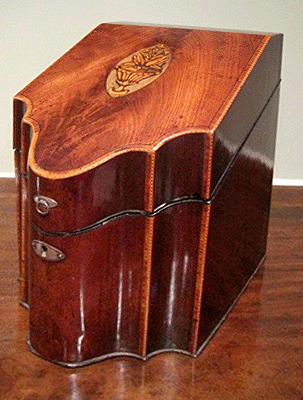 Eighteenth-century
knives and spoons, like tea, were items owned by the wealthy and required
special cases for their storage and display. The knife box became a symbol
of importance in any early dining room, since owning silver was a matter of
great prestige. Eighteenth-century
knives and spoons, like tea, were items owned by the wealthy and required
special cases for their storage and display. The knife box became a symbol
of importance in any early dining room, since owning silver was a matter of
great prestige.
Usually made and sold in pairs, knife boxes had fitted with elaborately
grooved interiors to hold a variety of cutlery. And their molded brass locks
kept the family silver safe.
Articles of great rarity and value have historically been encased in boxes
of comparative artistic value. Craftsmen often fabricated elaborate boxes to
protect valuables against damage, and more often, theft. Sometimes elegant
boxes offered a means of displaying that which they contained to the best
advantage.
Early recorded illustrations of knife boxes date from 1649., but the
generally their date from the 1720s. From this time onward, mentions of
cases of wood or shagreen (leather) appeared in letters and household
inventories.
In 1738, Peter Faneuil, when ordering from London the furniture and silver
for his house in Boston, begged a friend to procure for him " a shagreen
case with a dozen of new knives and forks of a handsome silver handle, and
the best blades you can get made in London, for my own use, with room in the
case for a dozen spoons...Pray let the case be the same with that Mr. Baker
sent me lined in red velvet." Up to the time of the American Revolution,
wealthy homeowners imported their knife boxes from England.
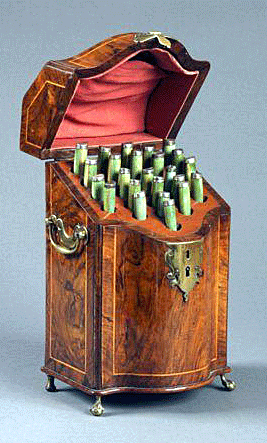 But
by the middle of the 17th century, knives and forks of silver, silver gilt,
and gold became a means for the wealthy to preserve their fortunes. The
finest cutlery of the time had mounts and handles in porcelain, enamels, or
finely-chased metal. Since the valuable knives, forks and spoons of the
wealthy class were status symbols, they required display cases for storage
that were worthy of the contents. Most, constructed of wood, incorporated
sloping, hinged covers enclosing a pierced panel to retain the cutlery and
flatware, with serpentine-shaped fronts and small bracket feet. From the
early part of the 18th century, these special knife boxes or cases stood on
a sideboard in the formal dining room. But
by the middle of the 17th century, knives and forks of silver, silver gilt,
and gold became a means for the wealthy to preserve their fortunes. The
finest cutlery of the time had mounts and handles in porcelain, enamels, or
finely-chased metal. Since the valuable knives, forks and spoons of the
wealthy class were status symbols, they required display cases for storage
that were worthy of the contents. Most, constructed of wood, incorporated
sloping, hinged covers enclosing a pierced panel to retain the cutlery and
flatware, with serpentine-shaped fronts and small bracket feet. From the
early part of the 18th century, these special knife boxes or cases stood on
a sideboard in the formal dining room.
By the mid-18th century, British cabinetmakers and joiners became prosperous
manufacturing knife boxes. By the 1790s, the valuable cutlery and flatware
of the nobility had become a part of the beginning development of social
graces that eventually filtered down to the emerging middle class.
Unfortunately, knife boxes fell out of favor about 1820, and from then on
sideboards included a separate cutlery drawer.
Designing and making knife boxes evolved into an art, as craftsmen sought to
perfect what began as a simple container into one of elegant beauty and fine
lines. Interiors had elaborate rectangular partitions into which knives and
forks could be inserted handles up and spoons bowl upwards, thus displaying
the objects in tiers upon the slope. The mountings of these cases were, in
certain cases, of pierced and engraved silver. Beautiful woods and wood
grains had been recognized and appreciated for their beauty since early in
the history of furniture making and thus became an integral part of knife
box design..
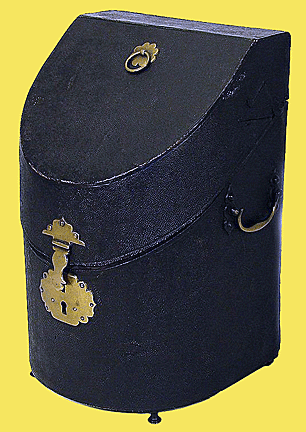 Cabinetmakers
constructed the earliest knife boxes cheap fir or pine and covered them with
shagreen, a leather made of untanned horsehide into which they pressed small
seeds. Afterwards, it was then dried out and soaked. The impression of the
seeds, after they had been removed, swelled up and made an interesting
textured pattern on the leather which could be easily dyed.The color most
often used was green, although craftsmen sometimes used red. Others
experimented with tooled leather. After covering the wooden carcasses of the
boxes with shagreen, box makers attached silver fittings to the corners to
protect them from wear. Cabinetmakers
constructed the earliest knife boxes cheap fir or pine and covered them with
shagreen, a leather made of untanned horsehide into which they pressed small
seeds. Afterwards, it was then dried out and soaked. The impression of the
seeds, after they had been removed, swelled up and made an interesting
textured pattern on the leather which could be easily dyed.The color most
often used was green, although craftsmen sometimes used red. Others
experimented with tooled leather. After covering the wooden carcasses of the
boxes with shagreen, box makers attached silver fittings to the corners to
protect them from wear.
In the latter part of the 18th century, craftsmen designed and made knife
boxes in the Hepplewhite and Sheraton styles with slant fronts, hinged lids,
and beautiful veneered surfaces. Urn-shaped cases, usually constructed of
satinwood, in the style of Robert Adam of the Adams Brothers of London,
became a popular adornment on Neoclassic style sideboards from 1780 to 1800.
The Neoclassic Revival and the subsequent designs applied to the interior
decoration led to the repeated use of the classic urn shape. Copies of
Grecian urns, each round and about two feet tall, had a cover attached to a
center rod. Makers arranged the partitions for the knives concentrically
around this central stem, to which the lid, which could be raised and
lowered, was secured and kept up by a spring when required. Usually, they
made them in pairs or sets of three with a smaller case for spoons, with
Neoclassic carving and decoration.
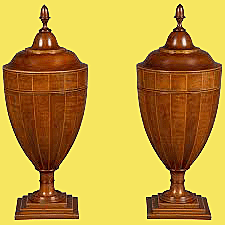 For
example, a satinwood urn knife case in the Victoria and Albert Museum
features painted medallions enclosing landscapes and fruit upon a background
of festoons of drapery and other ornamentation. Often, the urns were divided
by vertical lines of stringing. Bases were sometimes carved in a waterleaf
pattern. Examples of high quality with decorative motives, distinctive of
the Regency period are rare, but a remarkable pair of knife urns, in the
possession of the Royal family of England, have, at the angles, four
terminal figures finely carved in the Egyptian style. Once placed separately
on pedestals at the end of sideboards, these urn cases eventually became
affixed to their pedestals with an elongated foot, while their bodies grew
heavy and angular. For
example, a satinwood urn knife case in the Victoria and Albert Museum
features painted medallions enclosing landscapes and fruit upon a background
of festoons of drapery and other ornamentation. Often, the urns were divided
by vertical lines of stringing. Bases were sometimes carved in a waterleaf
pattern. Examples of high quality with decorative motives, distinctive of
the Regency period are rare, but a remarkable pair of knife urns, in the
possession of the Royal family of England, have, at the angles, four
terminal figures finely carved in the Egyptian style. Once placed separately
on pedestals at the end of sideboards, these urn cases eventually became
affixed to their pedestals with an elongated foot, while their bodies grew
heavy and angular.
The crafting of veneered knife boxes, especially the urn-shaped ones, was a
complicated process since the curved surfaces of both types presented
special problems. Once the boxes craftsmen contoured the boxes, they treated
the veneer with heated sizing so that it would conform to the curves without
splitting. They then coated the wooden carcass thinly with glue and allowed
it to dry. After the veneer had been soaked in size, they pressed it onto
the wood using a heated, inverted form of the contour shape. Using clamps to
press it all together and
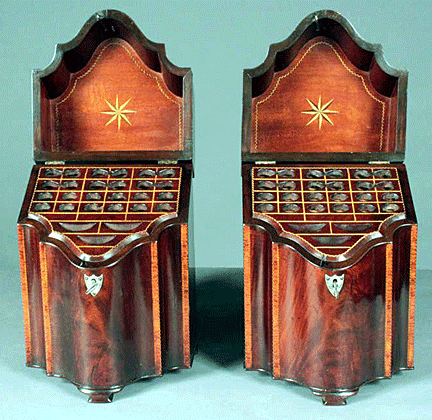 eliminate
the excess size and glue, they then waited for the veneer to adhere and
harden onto the wood. When it was dry and hard, they removed the outside
form. They applied flat surfaces of veneer using a veneer hammer. Final
staining and polishing and several hand waxings finished the outside of the
knife box. eliminate
the excess size and glue, they then waited for the veneer to adhere and
harden onto the wood. When it was dry and hard, they removed the outside
form. They applied flat surfaces of veneer using a veneer hammer. Final
staining and polishing and several hand waxings finished the outside of the
knife box.
Craftsmen paid special attention to the interiors. They covered partitions
for knives in felt or velvet and lined the undersides of the lids. They even
veneered some knife boxes on the inside and many had marquetry borders
around the inside edges to match those on the outside. The addition of
hardware and mountings of silver or brass finished off the boxes.
Knifeboxes and Veneers
Motifs in veneered inlay, such as the conch shell and the Prince of Wales
plumes, added restrained decoration to the slanted tops of Hepplewhite and
Sheraton knife boxes. Specialists made these veneer motifs separately and
sold them to box makers, who would then inlay the motif during the veneering
process.
Veneering, the process of gluing thinly cut layers of precious wood to
surfaces of less exotic wood, goes back to ancient times and grew in
popularity during the Renaissance, when inlay designs were common forms of
furniture decoration. Though the art of wood veneer decoration had existed
for several centuries, the perfection of the technique and the height of its
popularity came in the 17th and 18th centuries. The French set the style in
marquetry inlay, and the British soon followed suit.
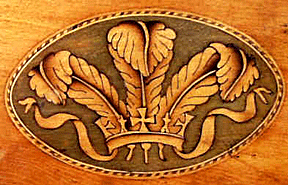 The
same increase of exploration and trade that brought tea to the Europeans
also brought a variety of exotic woods, even though they came in small
quantities at high cost. An advantage of wood veneering was that small
quantities could be made to cover a much larger area of local, less
expensive woods by slicing the rare wood into thin sheets. The
same increase of exploration and trade that brought tea to the Europeans
also brought a variety of exotic woods, even though they came in small
quantities at high cost. An advantage of wood veneering was that small
quantities could be made to cover a much larger area of local, less
expensive woods by slicing the rare wood into thin sheets.
Eventually inlaid designs of colored veneers became the predominant style or
decoration. Craftsmen used fine wood veneers, the most popular being
mahogany used in combination with other woods such as satinwood, ebony,
rosewood, sycamore, tulipwood, pear, olive, walnut, and elm. Knife boxes
show some of the best examples of this technique, since craftsmen lavishly
inlaid both their exteriors and interiors with neoclassical motifs and
borders.
There were several reasons to use veneer, not the least important being
cost. Covering a box with expensive wood veneer cost far less than making it
of a solid piece of the same wood. Using less domestic wood--often fruit
woods--for the carcass served well. Secondly, box makers could increase the
tensile strength of a surface many times when they laid veneer cross grain
to the under piece of wood. The additional feature of a layer of glue
between the two surfaces also added to the strength of the finished product.
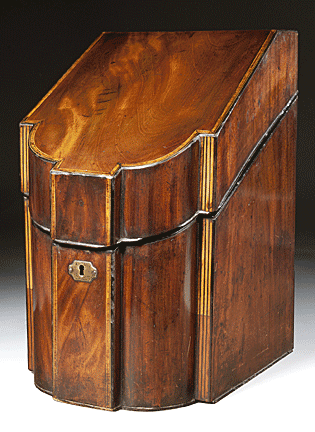 Veneers
also offered aesthetic advantages in the decoration of knife boxes. The
craftsman, by using thinly cut sheets of the same piece of wood, could
repeat the grainings and markings in order to form interesting patterns.
This use of the natural design in wood required artistry as well as
craftsmanship. By using veneers judiciously, the maker could inlay designs
and decorations of different kinds and colors of wood, thus producing unique
motifs. Veneers
also offered aesthetic advantages in the decoration of knife boxes. The
craftsman, by using thinly cut sheets of the same piece of wood, could
repeat the grainings and markings in order to form interesting patterns.
This use of the natural design in wood required artistry as well as
craftsmanship. By using veneers judiciously, the maker could inlay designs
and decorations of different kinds and colors of wood, thus producing unique
motifs.
During the 18th century, craftsmen knew of no methods of cutting large
enough slabs of wood to the desired thinness in order to cover entire
surfaces of the boxes with single sheets of the more precious woods.
Therefore, small pieces of wood were cut and glued to the carcass of a box
in patterns and designs that took advantage of the beauty of the wood grain
and variations in color.
Highly skilled, specially trained veneer cutters sliced the layers of
expensive wood into thin sheets of uniform thickness. They then sold them to
box makers. The earliest methods of cutting veneers by hand produced only
vertically cut grains. This vertical slicing produced a circular pattern
known as "oystering." Other patterns are the "burl," a growth on the tree
trunk and a particularly attractive gnarled design, and the "bird's eye"
formed by the deep growth of buds mostly commonly found on the maple tree.
By featuring the natural grain of the wood, knife box makers could repeat
the "flame" pattern in mahogany or the "burl" in walnut and make them the
main design element.
Woods often used in knife box veneers included chestnut, poplar, walnut,
elm, birch, rosewood, primavera, ebony, satinwood, sandalwood, sycamore,
box, yew, olive, pear, teak, tulipwood, laurel. But mahogany was far and
away the most popular. Its figurations are unmatchable for their beauty, and
it takes a high polish extremely well.
Though knifeboxes began as utilitarian objects, they became things of beauty
and some even became works of art.
<
Back to
Antiques Articles
Go to the next antiques article >
|
